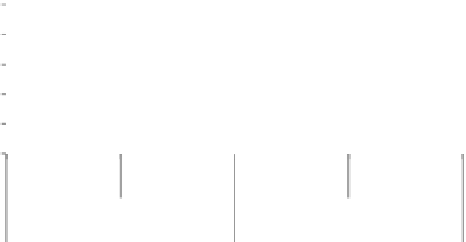Biomedical Engineering Reference
In-Depth Information
over the body. Besides, micro-movement could be measured, (see Fig. 8b and 8c). For
breath measurement, the measurement accuracy of breathing rate was 89.7% (SD =
0.05) in the side-lying position and it was 92.8% (SD = 0.05) in the supine position in
the circumstance of sleeping with no quilt Moreover, the measurement accuracy of
breathing rate was 92.4% (SD = 0.07) in the side-lying position, and it was 92.7%
(SD = 0.07) in the supine position. Overall, the average accurate rate of breath mea-
surement was 92.03% (SD = 0.044). The comparison of the breath measurement in
these different conditions is shown in Fig. 10.
For sleep position, the experimental results showed that in the circumstance of
sleeping with a thin quilt, the detection accuracy was 94.7% (N=19) in the side-lying
position, and it was 100% (N=21) in the supine position. Besides, while the user slept
with no quilt, the detection accuracy was 88.23% (N=17) in the side-lying position,
and it was 100% (N=20) in the supine position.
100%
80%
92.8%
91.9%
89.7%
93.4%
60%
40%
20%
0%
Side lying
Supine
Side lying
Supine
Sleep without quilt
Sleep with a thin quilt
Fig. 10.
Measurement results of breath measurement in experiment II
5
Discussions
The aim of this section is to summarize, analyze and discuss the results of experi-
ments and give guidelines for the future developments.
5.1
Head/Torso Detection
From the experimental results of head and torso detection, we observed some issues
worthy of discussion. First, while the user slept with a thin quilt, the overall detection
accuracy of torso was better than uncovered. One reason might be that the thin quilt
could smooth the shape of the torso, and enhance the measurement accuracy. Second,
we found that the gesture might affect the head detection. In this system, the head and
torso could be detected accurately under the premise that the shape of the head or
torso is not overlapped by hand or other objects. Fig. 11a and 11b show two special
sleep gestures that can be detected accurately. It is because that the shape of the head
is not overlapped. However, there are some conditions that the head or torso could not
be detected well. According to the observation, we found that the head could not be
detected well while the user is scratching (Fig. 11c and 11d). In this condition, the
shape of the head might be changed and no longer a sphere contour. In this case, the










Search WWH ::

Custom Search